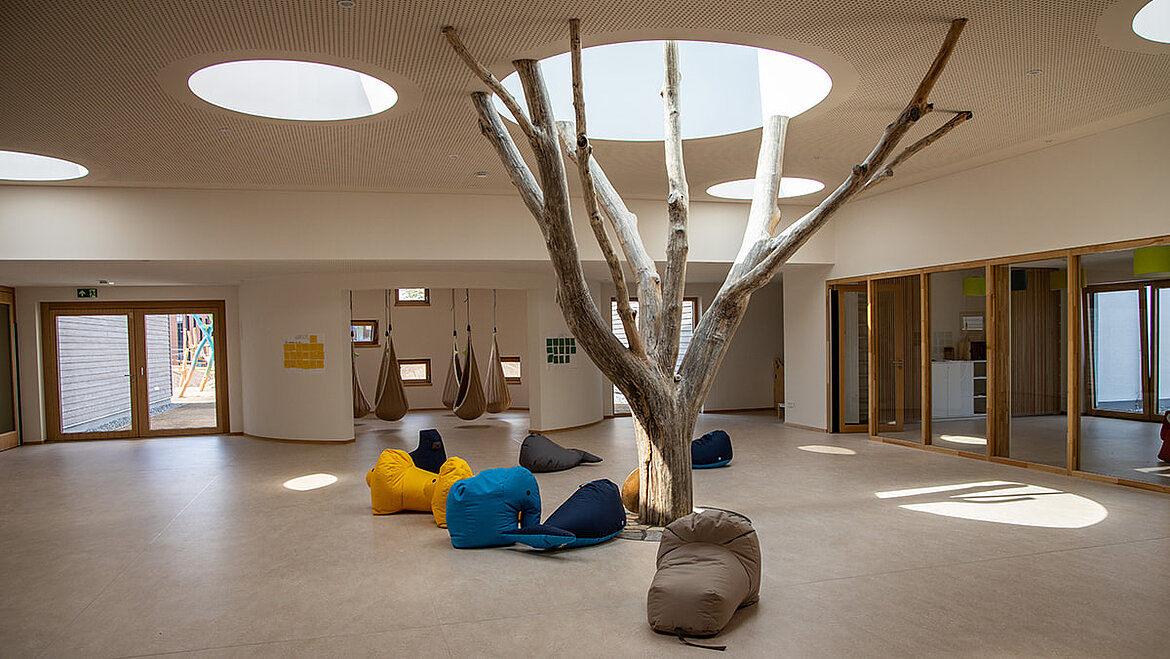Since children spend a large part of their time in facilities such as daycare centres or schools, their architecture should not only be suitable for children, but also have educational value. Manuel Wohlrab, head of the LamiKita in Rehau, explains what is important when planning such a facility and how much daylight a child really needs.
Daylight means pure quality of life
Manuel Wohlrab is 40 years old, father of a patchwork family of six and lives on a renovated farm in the middle of nature. Not only with his children, but also in his job as head of a daycare centre, it is important to him that children can try out their skills in a protected environment. They should have the opportunity to discover and explore new things every day. In addition to a trusting cooperation between the educators, parents and children, architecture plays a major role for him to achieve this.
The head of the daycare centre explains: “The children should feel comfortable and safe in the rooms of the facility, but meanwhile the staff has to keep an eye on everything. Thanks to glass partition walls within the LamiKita, this is possible. That way the children can see what is going on in the surrounding rooms at all times and the teachers have a good overview of what is happening”. Manuel Wohlrab’s answer to anyone who now thinks that the children are distracted too quickly as a result is the following: “Due to the open design of our rooms the children have to learn to deal with distraction. This is also important for their later life. They can decide for themselves whether they allow the distraction. For tasks that require a high level of concentration, there are also corners where the children can fiddle and work on things without being disturbed”.

Impact of daylight on child development
The LamiKita does not follow a particular well-known pedagogical concept, but has selected the appropriate elements from various concepts and developed a very own concept from them. According to the Reggio pedagogy, for example, the LamiKita tries to encourage the strengths of the children and not work against the weaknesses of the children. The Reggio pedagogy goes even further and assigns the role of an educator to the architecture and interior design. In doing so, the design of a room has to be functional and self-explanatory for the children. “A room with large windows gives the child the opportunity to observe nature, follow the sun’s course or watch the clouds move,” explains Manuel Wohlrab. “Daylight is also incredibly important for the bodily functions of the little ones. Metabolism, hormone balance and brain function, all these are influenced and controlled by daylight.” An international study recently showed how important daylight is for children's vision. A lack of daylight leads to myopia eventually. When children spend 30 to 120 minutes a day outdoors, visual impairments are significantly reduced. Since the luminance from above is three times higher than from the side, skylights are particularly suitable for flooding a room with daylight. These are available in a wide variety of designs and sizes. Round glass skylights, such as the LAMILUX Glass Skylight F100, look particularly aesthetic.
Light and shadow as playmates
However, the importance of high-quality shading should also be considered when planning daycare facilities. Especially in the sleeping rooms or during meditation it is important that the children can relax in a darkened room. In summer, the rooms also have to be protected from heat and in case the sunlight dazzles the children too much, the teachers need the possibility of creating shade. “Shadow does not mean darkness. Light and shadow are also excellent playmates,” says Manuel Wohlrab. What does it look like when light meets wood? What changes when light hits glass? How do mirroring and reflections occur? When is my shadow small, when is it big? Why can I not touch light and shadow? These questions awaken the spirit of research in children and help them to better understand nature and its physical laws. Daylight therefore plays a major role in the education of children.

When Manuel Wohlrab is asked about the perfect daycare centre, he beams and answers: “Obviously: The LamiKita. This is where educators’ dreams come true. The light-flooded rooms and the large outdoor area are something special.” To realize all this though, reliable partners and craftsmen are needed. LAMILUX installed eight round Glass Skylights with a diameter of 150 cm and a round Glass Roof with a diameter of 270 cm in the LamiKita. Thanks to the elements used, the total glass area on the roof of the LamiKita is almost 17 square meters. Moreover, all elements offer triple glazing with sun protection and external shading — perfect for watching the clouds and the play of shadows in all weathers.
LAMILUX is a professional when it comes to daylight and offers many more ideas and inspirations about daylight in kindergartens, daycare centres and schools.


